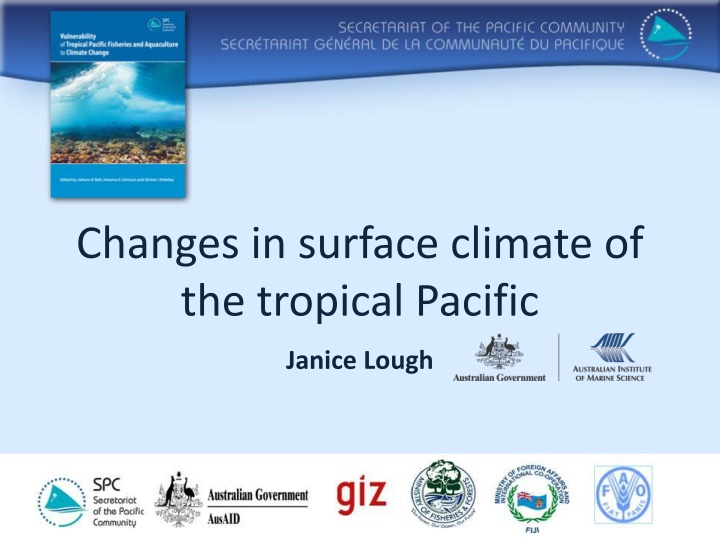
Climate Dynamics in the Tropical Pacific
Explore the surface climate changes, historical human impacts on climate, key messages about climate change, global energy redistribution in the climate system, Pacific atmospheric circulation, sea surface temperature variations, seasonal cycles, tropical cyclones, and El Niño-Southern Oscillation in the tropical Pacific region.
Download Presentation

Please find below an Image/Link to download the presentation.
The content on the website is provided AS IS for your information and personal use only. It may not be sold, licensed, or shared on other websites without obtaining consent from the author. If you encounter any issues during the download, it is possible that the publisher has removed the file from their server.
You are allowed to download the files provided on this website for personal or commercial use, subject to the condition that they are used lawfully. All files are the property of their respective owners.
The content on the website is provided AS IS for your information and personal use only. It may not be sold, licensed, or shared on other websites without obtaining consent from the author.
E N D
Presentation Transcript
Changes in surface climate of the tropical Pacific Janice Lough
History of human influence on climate: 1896 A simple calculation shows that the temperature in the arctic regions would rise about 8oto 9oC, if the carbonic acid increased to 2.5 or 3 times its present value S. Arrhenius Philosophical Magazine and Journal of Science 1896 (1903 Nobel Prize winner) CO2290 ppm 0.7oC cooler 20cm lower sea level 0.1 higher ocean pH 75% fewer people
Key messages We are all used to current climate and seasons Humans affecting climate system Climate is already changing Models imperfect but provide possible futures Future will be warmer Some places will be wetter and some drier Extreme weather likely to be more extreme Our climate will be changing for foreseeable future
Redistributing suns energy = climate system Global annual mean energy budget W m-2 Trenberth et al 2009 without atmosphere Earth ~30oC cooler more greenhouse gases trap more energy in climate system
Pacific atmospheric circulation heat engine ocean dominates island climates trade winds convergence zones Fiji sensitive to SPCZ position Walker and Hadley circulations
Seasonal cycles: wind, rainfall, temperature Winds Rain Temperature
Tropical cyclones: destructive weather events TC Jasmine Feb 12 2012
El Nio-Southern Oscillation (ENSO) major source year-year climate variations centred in tropical Pacific evolves over 12-18 months seasonal forecasts
Typical El Nio and La Nia SST anomalies Warmer (red) or cooler (blue)
Typical El Nio and La Nia rainfall anomalies Wetter (green) or drier (orange)
ENSO shifts SPCZ and tropical cyclones El Ni o further north El Ni o further south La Ni a La Ni a fewer cyclones further east El Ni o more cyclones further west La Ni a
Climate also varies on decadal timescales c 3 2 1 PDO index 0 -1 -2 -3 1871 1891 1911 1931 1951 1971 1991 Year Pacific Decadal Oscillation (PDO) cooler: SPCZ displaced SW & ENSO variability stronger warmer: SPCZ displaced NE & ENSO variability weaker
Results in average seasonal climate what we expect = climate includes variability (range) what we get = weather
Why are climate scientists so sure climate is changing due to human activities? theory modelling evidence: instrumental measurements changes in the physical world changes in the biological world paleoclimate archives The climate system appears to be changing faster than earlier thought likely Steffen 2009
Measured increase in carbon dioxide 18thcentury = 280ppm air bubbles in ice cores 2011= 391ppm Mauna Loa
Observed warming of global temperatures PCCSP 2011 Suva
Projecting future climates Temperature (oC) Scenario IPCC-AR4 (2007) Low emissions (B1) High emissions (A2) CO2 (ppm) +1.8 (1.1-2.9) +3.4 (2.0-5.4) 450-500 750-800 good observations understanding of climate system realistic models predict future forcing how much more greenhouse gases? downscaling to scales that matter to us Range of possible futures
Projected surface temperature warming averages from several models spatial difference in magnitude the future will be WARMER
Projected rainfall changes wetter convergence zones drier subtropics more extreme wet years more intense droughts
Extremes The answer to the oft-asked question of whether an event is caused by climate change is that it is the wrong question All weather events are affected by climate change because the environment in which they occur is warmer and moister than it used to be Trenberth 2012 Preparing for TC Jasmine Vanuatu
Possible new climates Temperature oC Tarawa Funafuti Nadi Raratonga Pitcairn Now 28.2 28.0 25.6 23.9 20.9 2035 28.9 28.7 26.3 24.6 21.6 2050 29.9 29.4 27.0 25.3 22.1 2100 31.4 30.9 28.5 26.6 22.8 Rainfall mm Tarawa Funafuti Nadi Raratonga Pitcairn Now 725 1,160 785 425 380 2035 780 2025 800 1,250 2100 835 1,340 900 490 320 460 350
Summary future will be warmer some islands wetter and some drier maybe fewer but stronger tropical cyclones more frequent and stronger extreme weather events unclear how ENSO will change continued influence importance of RATE of change not just a new climate to which we can adapt For foreseeable future climate will be CHANGING
Challenge of staying below +2oC warming! Peters et al 2012
Thank you j.lough@aims.gov.au
